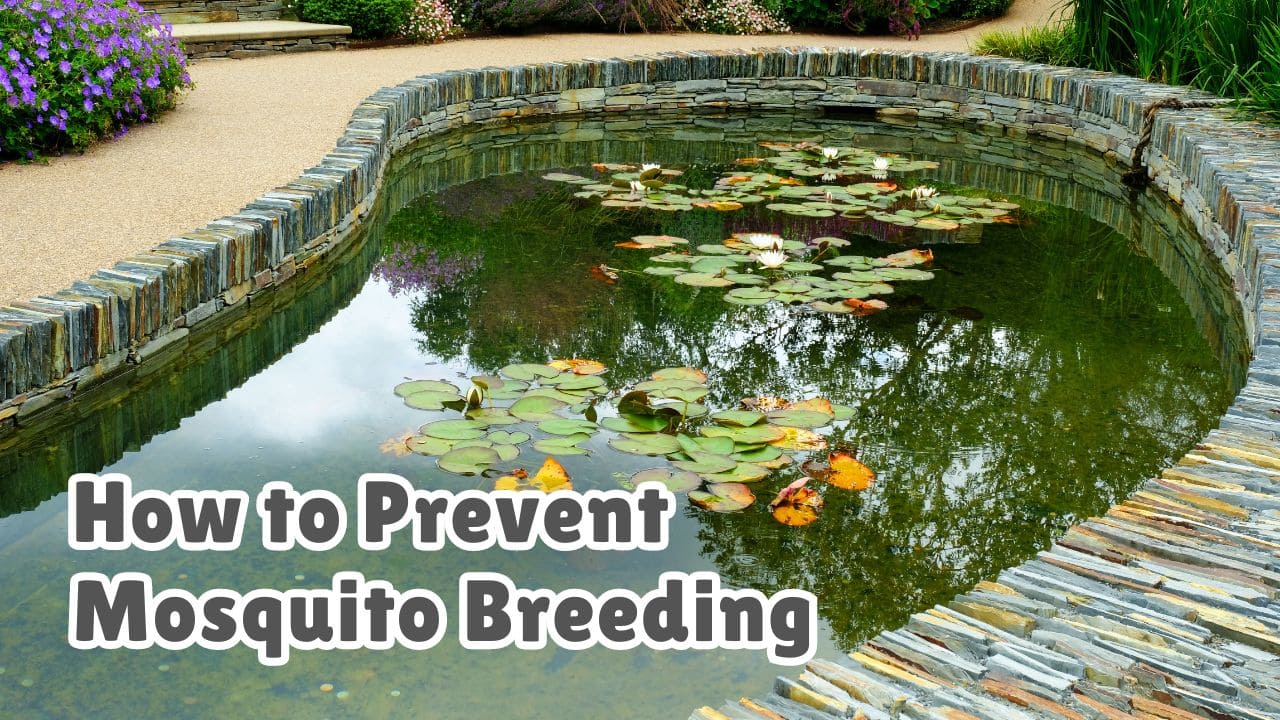Table of Contents
Mosquito breeding sites are those where female mosquitoes prefer to lay eggs, which later hatches into larva and than pupa and then finally emerges into an adult mosquito. These breeding sites are none other than stagnant water sources which remains stationary without any movement. These sites provide perfect conditions to serve as mosquito breeding grounds.
They are standing water bodies with sufficient organic matter to feed on and remains undisturbed. The conditions are favorable for mosquitoes to breed and hide, as they needed damp, shaded, humid environment.
It is comparatively easier to avoid breeding of mosquitoes in birdbaths, water troughs, rain barrels, etc. which requires regular cleaning and prevention from rain water collection. While larger water bodies like ponds, pools and spas are difficult to clean and maintain.
Potential mosquito breeding sites around your home
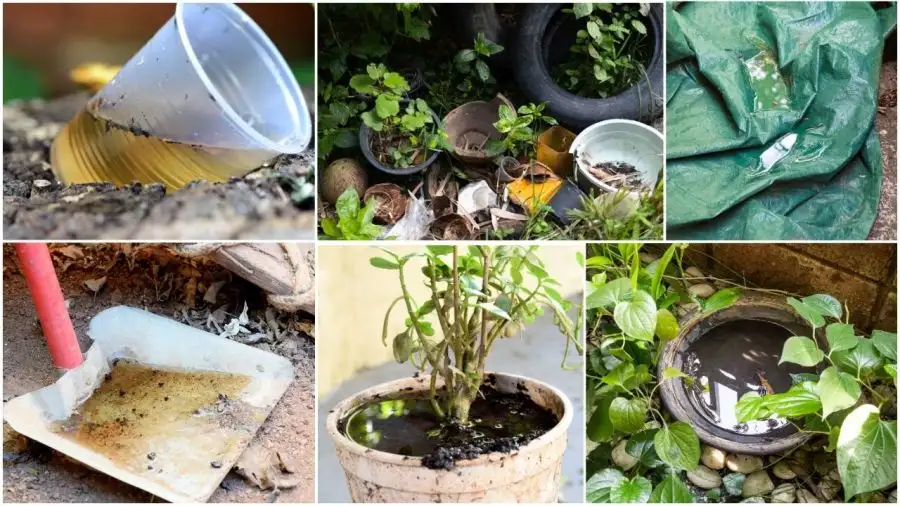
Image Credit: Designed by Canva Pro
There are many potential mosquito breeding sites which if not maintained or checked regularly, may allow mosquito infestation and become mosquito hubs. These places include ponds, swimming pools, bird baths, potted plants, etc. In order to prevent mosquito breeding in water, we need to keep a check on all potential as well as common mosquito breeding sites as listed below:
List of common mosquito breeding sites in and around your home
| Sr. No. | Common Mosquito Breeding Sites |
|---|---|
| 1. | Ponds, fountains and water features |
| 2. | Swimming pools and spas |
| 3. | Drains and gutters |
| 4. | Discarded tires and tire-swings |
| 5. | Toilet bowls and clogged drainages |
| 6. | Bird baths, pet water bowls, etc. |
| 7. | Jammed rain-gutters on roofs |
| 8. | Water pooling due to leaking taps and faucets, dripping water from AC’s |
| 9. | Uncovered water tanks, containers, water troughs, rain barrels, etc. |
| 10. | Potted Plants, flower pots and saucers, water plants, flower vases, aquarium, etc. |
| 11. | Tree stumps, woodlog piles, compost piles, etc. |
| 12. | Puddles, low lying areas and marshlands |
| 13. | Garages, basements and attics |
| 14. | Children play sets, discarded furniture, etc. |
| 15. | Watering cans, broken pots, disposable containers, any spaces that may collect rain water. |
| 16. | Wagons and wheel barrows |
| 17. | Folds between tarps and car covers |
| 18. | Cement pools, tanks and cisterns, etc. |
How to destroy mosquito breeding places?
Mosquito breeding sites can be destroyed or eliminated by using various methods that kills mosquito larvae thriving in stagnant water bodies. We can use mosquito dunks and bits, chlorine or bleach, vinegar, dish soap or any vegetable or mineral oil for mosquito larvae control.
These will kill the mosquito larvae but can also have adverse effect on other useful micro-organisms, insects, pets and kids too. So, every method cannot be useful with each and every mosquito breeding site.
By understanding the actual mosquito breeding site, we can adopt a safe and effective method. For standing water bodies like ponds, fountains and water features where other organisms like fish, frogs, aquatic plants, insects, are present; we can’t use harsh chemicals like DEET, chlorine or bleach, etc. And so we have to make use of natural or safe methods like mosquito dunks.
While in swimming pools and spas, we can simply use chlorine to kill mosquito larvae via pool shock treatment. The methods that are to be selected for different water bodies are explained below:
Methods to prevent breeding of mosquitoes
Depending on the presence of other organisms in the water body or any direct contact with pets, birds and useful insects, we have to select the method. Also, it should be noted that we have to prevent breeding of mosquitoes by avoiding formation of favorable conditions as needed by mosquitoes for laying eggs.
How to prevent mosquito breeding in ponds and bird baths?
These are standing water bodies that are highly prone to mosquito infestation as they are quiet frequently neglected or unmaintained. In case of ponds, even the folds and spaces between large broad leaves of aquatic plants like water lilies, papyrus, water hyacinth, water lettuce, taro, etc. can become mosquito breeding sites.
Here we can’t use vinegar, chlorine, phenyl, insecticides, etc. as this may contain fish, aquatic plants, and directly accessible to many other useful organisms, like frogs, tadpoles, birds, bats, pets, bees, water fowls, etc. Therefore, we can use following preventive methods for ponds and bird baths:
1. Keep the water moving:
Mosquitoes prefer still water to lay their eggs. So, having a movement or any motion in your pond and birdbath is the most ideal option to prevent mosquito breeding. Installing a pump, aerator or creating a continuous waterfall to create a constant movement through water circulation or ripples will disrupt the stability in water and prevent mosquitoes from laying eggs.
For birdbaths, it is necessary to clean and maintain after every 2 to 3 days. You can add a small solar powered fountain or aquarium aerator or oxygen machine to prevent mosquito from laying eggs.
To prevent mosquitoes in water features and fountains are very simple as you need to install water circulating pump to induce agitation within the water.
2. Introduce natural predators:
There are certain natural mosquito predators that feeds on mosquito larvae. These includes gambusia (also called as mosquito fish), goldfish, koi, etc. Stocking these mosquito eating fish in your ponds will be an ideal solution.
For birdbaths, you can attract mosquito eating birds to your garden or backyard which will help you in keeping down the mosquito populations by eating mosquito larvae.
Other predators includes dragonflies, spiders and bats. They can be attracted by providing a habitat suitable for them like planting native plants and placing rocks for dragonflies to allow perching and keeping tall dense trees for bats.
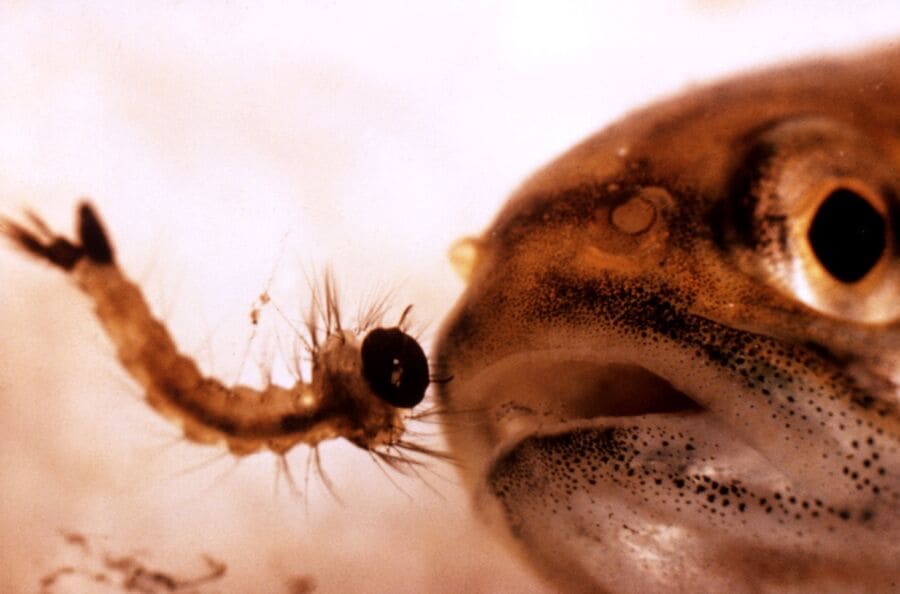
Image Credit: PIXNIO | Creative Commons
3. Use mosquito dunks or bits:
Mosquito dunks are made of BTI (Bacillus Thuringiensis Israelensis) which are natural bacterium that targets specificaly the mosquito larvae and do not harm fish, birds, pets, plants and useful insects. These mosquito dunks can be added to ponds and bird baths without any danger or harm to other living organisms.
It is safe for birds as well, and gives a long lasting protection by killing mosquito larvae before they develop into adult mosquitoes.
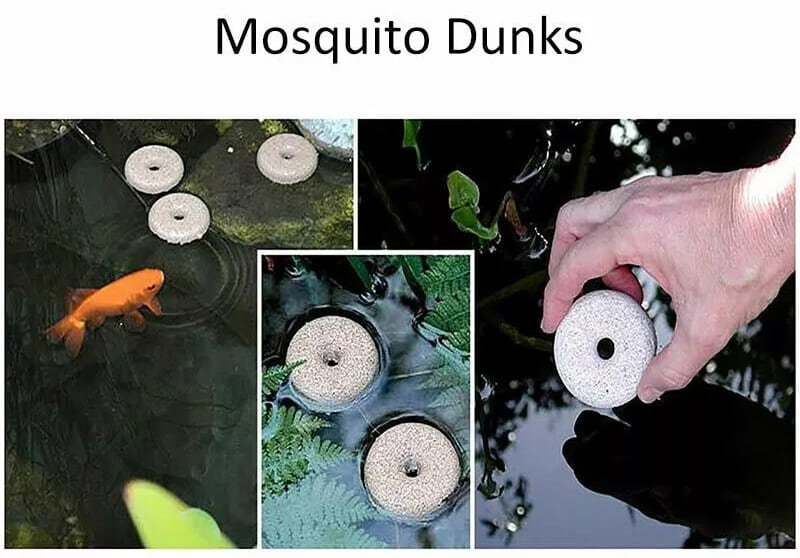
Image Credit: eBay
How to prevent mosquito breeding in pools and spas?
Swimming pools and spas if not properly maintained can become large mosquito breeding grounds which are capable of breeding millions of mosquitoes. They are very attractive to sites like pools where there is still water and organic matter like fallen leaves and algae to feed on. The effective methods to prevent mosquitoes from breeding and multiply are as follows:
1. Maintain adequate chlorine levels:
Adding chlorine in pool water and maintaining adequate levels around 1 to 3 ppm is ideal for preventing mosquitoes from laying eggs. Chlorine also kills other bacteria and prevents algal growth, and causes no harm to human skin at this levels. Regularly check and maintain the chlorine levels and pH of the pool water to keep it inhospitable for mosquitoes.
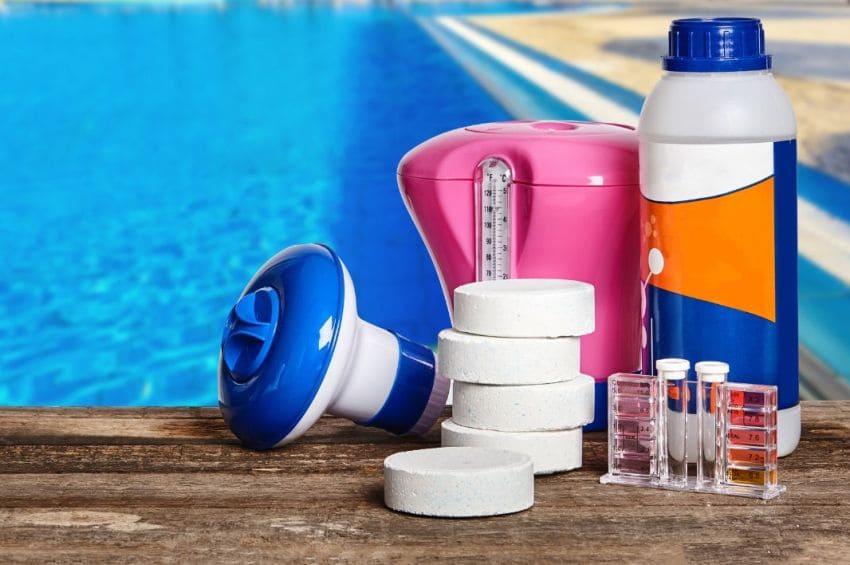
Image Credit: Canva Pro | Content License
2. Use pool cover:
Cover your pool with a pool cover or screen to prevent mosquito from entering or accessing the water. Check proper coverage of pools and make sure there are no gaps and tears, which can allow mosquitoes to enter and lay eggs.
Also, make sure there are no other water accumulation points or folds in the cover which can collect rain water and become micro breeding sites.
Take care of any low lying areas or uneven slopes near pools which can allow water pooling and subsequently creates an opportunity for mosquitoes to breed along with algae and bacterial growth.
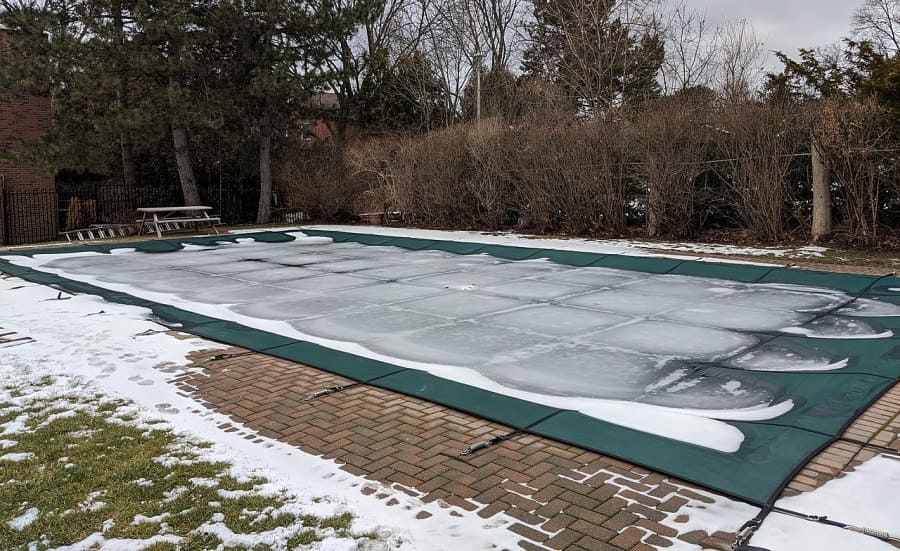
Image Credit: Wikimedia by Sikander Iqbal | Content License
3. Regular cleaning and maintenance:
Not only pool but other tools and equipments like skimmers, filters, spa and pool covers, buckets, mops, anti-skid perforated rugs, etc. should be emptied, washed, cleaned and kept dry.
How to prevent breeding of mosquitoes in stagnant water?
There are chances of mosquito breeding at any such places where water is contained without lids, or any spaces where rain water can accumulate. Places like puddles, children toys, broken furniture, empty plant pots, buckets, tires, water troughs, watering cans, toilet bowls, etc. are places which are often neglected and can easily trap or collect rain water and become micro mosquito breeding sites.
These are some important actions to prevent mosquitoes from breeding in stagnant water:
- Eliminate standing water bodies like puddles, gutters, etc.
- Change water frequently and keep the bird bath clean
- Install water circulating pumps or aerators to keep the water in constant motion
- Use mosquito dunks and bits
- Empty unwanted water containers or cover it with lid covers
- Ensure proper drainage and clean gutters
- Install mosquito nets in windows specially for toilet windows
- Remove any clutter that may collect rain water like tires, broken toys, empty plant pots, watering cans, gardening tools, etc.
- Stock mosquito eating fish in ponds
- Repair and maintain leaking water pipes, faucets, hoses, etc.
- Ensure proper chlorination and adequate pH and chlorine levels in pool water
- Repair or fill low lying areas and puddles where water pools and tends to collect
- Ensure water troughs, pet water bowls, are empty and keep them upside down
- Use dish soap, shampoo, phenyl, vegetable or mineral oil to kill the larvae by suffocation
- Use vinegar to kill mosquito larvae
- Use essential oils like lemon grass, eucalyptus, lavender, tea tree oil, rosemary, marigold to repel mosquitoes
These methods are effective in preventing mosquito breeding, but they can be used in combination to create a more effective solution against mosquito breeding.
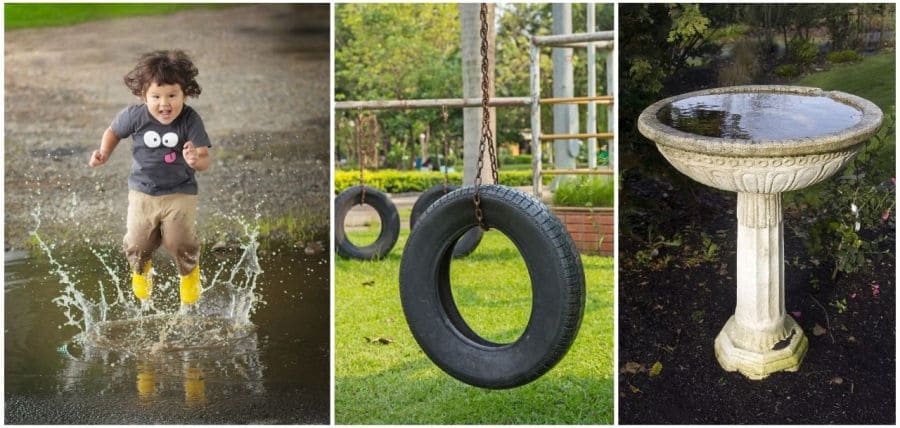
Image Credit: Canva Pro | Content License
Natural methods to prevent mosquito breeding in stagnant water
To control mosquito larvae naturally, there are natural methods also that will help in keeping mosquito populations under control. Following are some natural methods to prevent mosquito breeding in stagnant water:
- Empty or remove sources of standing water
- Grow natural mosquito repellent plants
- Attract mosquito eating birds
- Stock or introduce natural mosquito predators
- Spill or spray natural essential oils
Next Read: Things That Attract Mosquitoes to Your Home
Conclusion
Any water body with stagnant or still water without any movement are potential mosquito breeding grounds as they offer favorable conditions for laying eggs and larval growth. To prevent breeding of mosquitoes in stagnant water we have to eliminate unwanted standing waters.
Cleanliness, decluttering, and maintenence are the three most useful mantra for preventing mosquito breeding in water. There are routine actions and habits that we should follow to avoid any chances of water collection or pooling or left over by chance. Mosquito breeding sites like pool and ponds are difficult to maintain and clean and using pool cleaning services will be quiet expensive.
Therefore, to keep the environment mosquito free you should take small steps and efforts on a daily basis to care and maintain your surroundings in order to eliminate mosquito breeding sources.
Frequently Asked Questions (FAQs)
-
How to prevent mosquito breeding in drains?
Clean and repair any clogged or jammed drainage line. Avoid water pooling around the drains. For time being, add mosquito dunks to prevent mosquito breeding. Or else, add diluted liquid bleach or chlorine to the drains, which will kill the mosquito larvae and prevent mosquitoes.
-
How to prevent mosquito breeding in water plants?
Water plants are mainly kept inside your home and so avoiding or restricting mosquitoes to your home with the help of mosquito nets is easy. You can use esential oils in diffuser to keep mosquitoes away. You can add mosquito bits which is the safest and best option for water plants.

